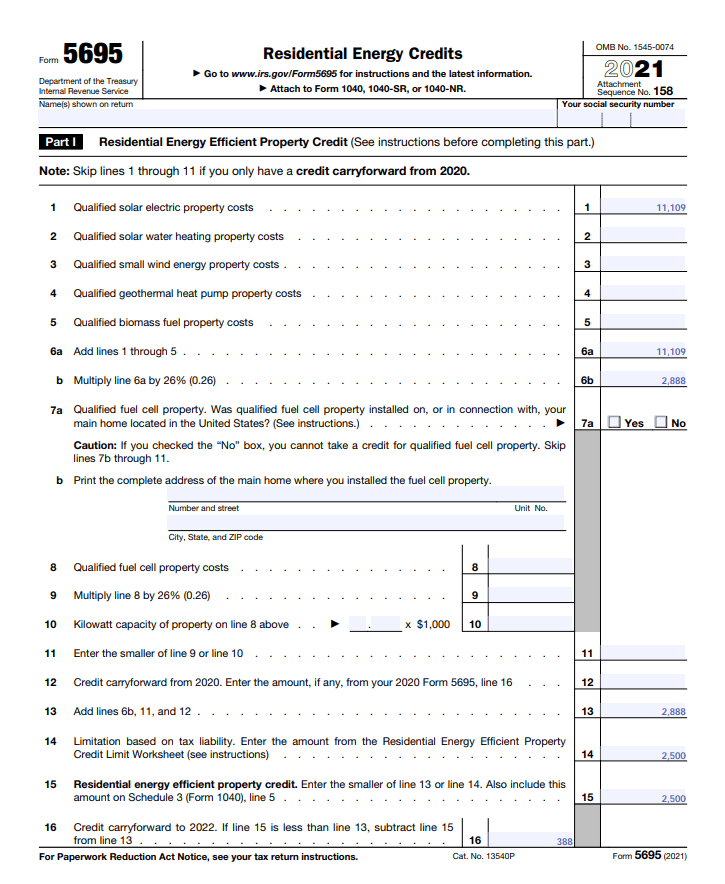
There are two versions of the Federal Solar Tax Credit: the Residential Renewable Energy Tax Credit (a personal tax credit) and the Business Energy Investment Tax Credit (corporate tax credit). This article pertains to the residential version.
Updated 8/25/22 – The Inflation Reduction Act has increased the Federal Solar Tax Credit to 30% (retroactive for grid-tied and hybrid systems installed at any point in 2022) and extended it to off-grid (standalone) systems installed after 12/31/22. The IRS has not yet released their revised Form 5695, so our example below uses 2021’s version and 26% tax credit amount.
One of the biggest immediate benefits of installing a solar electric system is that it comes with a substantial federal tax credit. It is called the Solar Investment Tax Credit (Solar ITC) and it allows the system’s owner to reduce the amount of federal tax they owe by 30% of the system’s cost for the year in which the system was installed. Of all the renewable energy incentives available for solar systems, this is the most substantial – and among the easiest to take advantage of.
Who Can Claim the Federal Solar Tax Credit (Solar ITC)?
A United States taxpayer can claim the Solar ITC when they have a solar electric system installed at and used by a residence that is both owned by and used by the taxpayer as a primary or secondary residence. In addition to owning the residence, the taxpayer must also be the owner of the solar system itself.
Ownership of both the residence and the solar electric system equipment is essential. If you’ve gone solar through a lease or power purchase agreement, you will not be able to claim this tax credit.
Installation and commissioning of the system can be done either by a hired contractor or by the homeowner. A DIY solar system installation can qualify for the Solar ITC so long as all other eligibility requirements are met.
Examples of systems not eligible for the Solar ITC:
- Systems installed at a rental property owned by the taxpayer
- Systems that have been modified since their original installation
- Systems that were installed and began being used in a year prior to the tax year for which you are attempting to claim the Solar ITC
- Systems not owned outright by the taxpayer, including systems installed under an equipment lease or power purchase agreement
What Parts of a Solar Electric System Are Covered by the Solar ITC?
The Solar ITC is more than a tax credit for solar panels. It also covers:
- Balance of system components (inverter, solar panel mounting equipment, and wiring)
- Batteries and energy storage devices that charge exclusively from the solar panels*
- Wiring and management software for eligible batteries and energy storage devices
- Shipping costs for all eligible equipment
- Contractor labor for site preparation, permitting, original installation, and inspection
- Tools bought or rented specifically for the system installation if you did a DIY installation
- Sales tax on all equipment and labor listed above
*Batteries and energy storage devices must be intended to be added to the system by its second year in use in order to qualify for the federal solar tax credit.
Does the Federal Solar Tax Credit Carry Over to the Next Year?
Yes. The Solar ITC amounts to 30% of the cost of the solar electric system’s components and installation. If that amount exceeds your tax liability, the remaining amount can be claimed on next year’s taxes. The federal solar tax credit form (form 5695) includes lines to designate and claim a carryover to the following year (referred to as a “carryforward” on the form).
Claiming the Federal Solar Tax Credit with Form 5695
Download IRS Form 5695 here, then complete it by following the instructions on Form 5695 itself. Use the detailed instructions on the IRS website for additional help and if necessary. Here’s an example of how this would go for a solar electric system for which you purchased the equipment from altE and then did the installation yourself.
- Line 1: Enter the gross cost of the qualifying equipment and installation costs of your solar electric system, minus any upfront/cash rebates you’ve already received for it. As with all U.S. tax forms, amounts should be rounded to the nearest dollar. In our example, the cost of the equipment, sales tax, and shipping would all be found on the invoice and there would be no installation costs since it’s a DIY installation.
- Lines 5 and 6: Complete the simple math as instructed to calculate the amount of your total Solar ITC.
- Line 12: Only necessary if you first claimed the Solar ITC during the previous tax year and are carrying over an unused portion to this year.
- Line 13: Complete the simple math as instructed. If you have no Solar ITC carryover from last year, this will simply be the amount you entered on line 6.
- Line 14: This is the amount of tax liability you have after the other tax credits you are claiming. This determines whether you can take advantage of the full Solar ITC amount (line 6) this year or whether you need to carry some of it over to next year. Enter the amount from line 3 of the worksheet on page 4 of Form 5695’s detailed instructions. In our example, we will assume $2,500 of tax liability available to apply the Solar ITC toward.
- Line 15: Complete the simple math as instructed to determine the amount of the Solar ITC you can claim for the current tax year.
- Line 16: Complete the simple math as instructed to determine whether you can carry any of the Solar ITC over to next year.
With Form 5695 completed, you’ll have the amount of your tax credit for the current tax year (line 15), which you can then include on line 5 of Schedule 3 for your Form 1040. In our example, we’re claiming $2,500 of our full Solar ITC amount, with the remaining $388 carrying over and allowing us to enter it on line 12 of Form 5695 next year.

In addition to the Federal Solar Tax Credit, be sure to check out other solar rebates and renewable energy incentives in your state, which can work together to save you as much as 50% or more on your installed solar system!
This article is for informational purposes only and should not be considered to be tax advice, legal advice, or accounting advice.
